In botany, the correct name according to the International Code of Nomenclature for algae, fungi, and plants (ICN) is the one and only botanical name that is to be used for a particular taxon, when that taxon has a particular circumscription, position and rank. Determining whether a name is correct is a complex procedure. The name must be validly published, a process which is defined in no less than 16 Articles of the ICN. It must also be "legitimate", which imposes some further requirements. If there are two or more legitimate names for the same taxon, then the correct name is the one which has priority, i.e. it was published earliest, although names may be conserved if they have been very widely used. Validly published names other than the correct name are called synonyms. Since taxonomists may disagree as to the circumscription, position or rank of a taxon, there can be more than one correct name for a particular plant. These may also be called synonyms.

Aspicilia is a genus of mostly crustose areolate lichens that grow on rock. Most members have black apothecia discs that are slightly immersed in the areolas, hence the common name"Given the same reason, the naming of Aspicilia is derived from the Greek word for "shield concave".
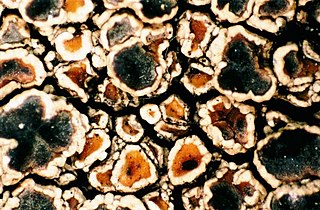
Megasporaceae are a family of fungi belonging to the order Pertusariales. Taxa are lichenized with green algae, and grow on rocks, often in maritime climates close to fresh water. Phylogenetic analysis has shown that this family is related to the Pertusariaceae, another family of lichens. The genus Aspicilia was moved here from the Hymeneliaceae.

The Pertusariaceae are a family of lichen-forming fungi in the order Pertusariales.
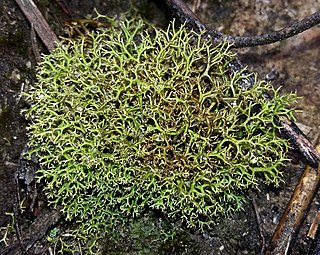
Cladia is a genus of lichen-forming fungi in the family Cladoniaceae. Cladia species have a crustose or squamulose (scaly) primary thallus and a fruticose, secondary thallus, often referred to as pseudopodetium. The type species of the genus, Cladia aggregata, is widely distributed, occurring in South America, South Africa, Australasia and South-East Asia to southern Japan and India. Most of the other species are found in the Southern Hemisphere.
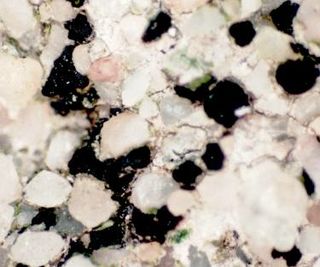
Sarcogyne is a genus of crustose lichens in the family Acarosporaceae. It was circumscribed by German botanist Julius von Flotow in 1850. A proposal has been put forth in 2021 to assign Sarcogyne clavus as the type species of the genus, "as it represents the original concept of Sarcogyne as having melanized lecideine apothecia without algae in the margin".

Opegrapha is a genus of lichenized fungi in the family Opegraphaceae. Species include:
Roccellina is a genus of lichen-forming fungi in the family Roccellaceae.
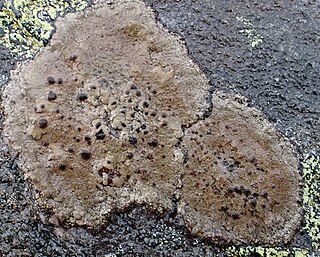
Fuscideaceae is a family of lichen-forming fungi in the order Umbilicariales. It contains five genera and about 55 species of crustose lichens.
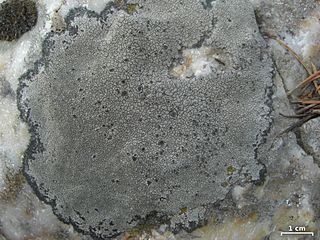
Bellemerea is a genus of saxicolous (rock-dwelling) crustose lichens in the family Lecideaceae. The genus was circumscribed in 1984 by Josef Hafellner and Claude Roux, with B. alpina as the type species. The generic name honours French lichenologist André Henri Bellemère (1927–2014).

Clauzadea is a genus of lichenized fungi in the family Lecideaceae. The genus contains four species found in Europe. Clauzadea was circumscribed in 1984 by lichenologists Josef Hafellner and André Bellemère.

Coccotrema is a genus of lichen-forming fungi. It is the type genus of the family Coccotremataceae, in the order Pertusariales. The genus contains 16 species.

Lobothallia is a genus of lichens in the family Megasporaceae. Species in the genus have foliose thalli that become crustose areolate in the center with age, and grow on calcareous to siliceous rocks. The crustose part of the body may keep its lower cortex, though not always. Dark brown to black apothecia may be sunken into the surface of the thallus, as indicated in the common name puffed sunken disk lichen. Members grow to 3–5 cm (1.2–2.0 in) or more radiating lobes (placodioid). The photobiont is green alga from the genus Trebouxia. The genus is represented in Eurasia, Asia, North Africa, Central America, western North America, and Australia.
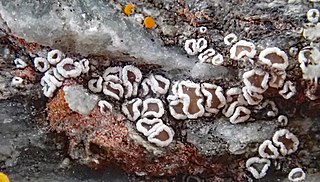
Myriolecis is a genus of lichen in the family Lecanoraceae. It was originally circumscribed in 1909 by Frederic E. Clements with Myriolecis sambuci as the type species. The genus was later reinstated to accommodate the Lecanora disperse group and Arctopeltis. Molecular phylogenetic data showed that this group of species formed a clade that is genetically distinct from Lecanora, and Myriolecis was the oldest name available to hold these species.

Abrothallus parmeliarum is a species of lichenicolous fungus. It grows on the thallus and apothecia of Parmelia species. The fungus was first described scientifically by the Norwegian botanist Søren Christian Sommerfelt in 1826. In 2018, a proposal was made to conserve the name Lecidea parmeliarum, against Endocarpon parasiticum, an older basionym dating from 1814. The conservation was recommended in 2023 by the Nomenclature Committee for Fungi due to the widespread use and recognition of Abrothallus parmeliarum as a common lichenicolous fungus, despite the priority of the lesser-used Endocarpon parasiticum. This action was supported to preserve the nomenclatural stability of what is considered the best-known species name among lichenicolous fungi.

Bilimbia is a genus of lichen-forming fungi in the family Ramalinaceae.
Eiglera is a small genus of crustose lichens belonging to the monotypic family Eigleraceae. Eiglera species are found in Europe and Northern America.

Schaereria is a genus of lichen-forming fungi. It is the sole genus in the family Schaereriaceae, which itself is the only family in the Schaereriales, an order in the subclass Ostropomycetidae of the class Lecanoromycetes. Most Schaereria species are crustose lichens that live on rocks. Schaereria was first proposed by Gustav Wilhelm Körber in 1855 and was later taken up by other lichenologists despite periods of disuse.
Claude Roux is a French lichenologist, mycologist and Esperantist. He has co-authored books about the identification of lichens written in Esperanto.
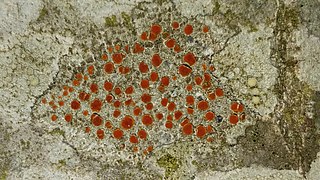
Blastenia ferruginea is a species of corticolous (bark-dwelling), crustose lichen in the family Teloschistaceae. It has a cosmopolitan distribution.
















